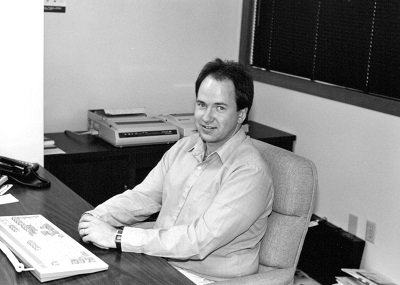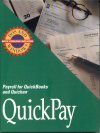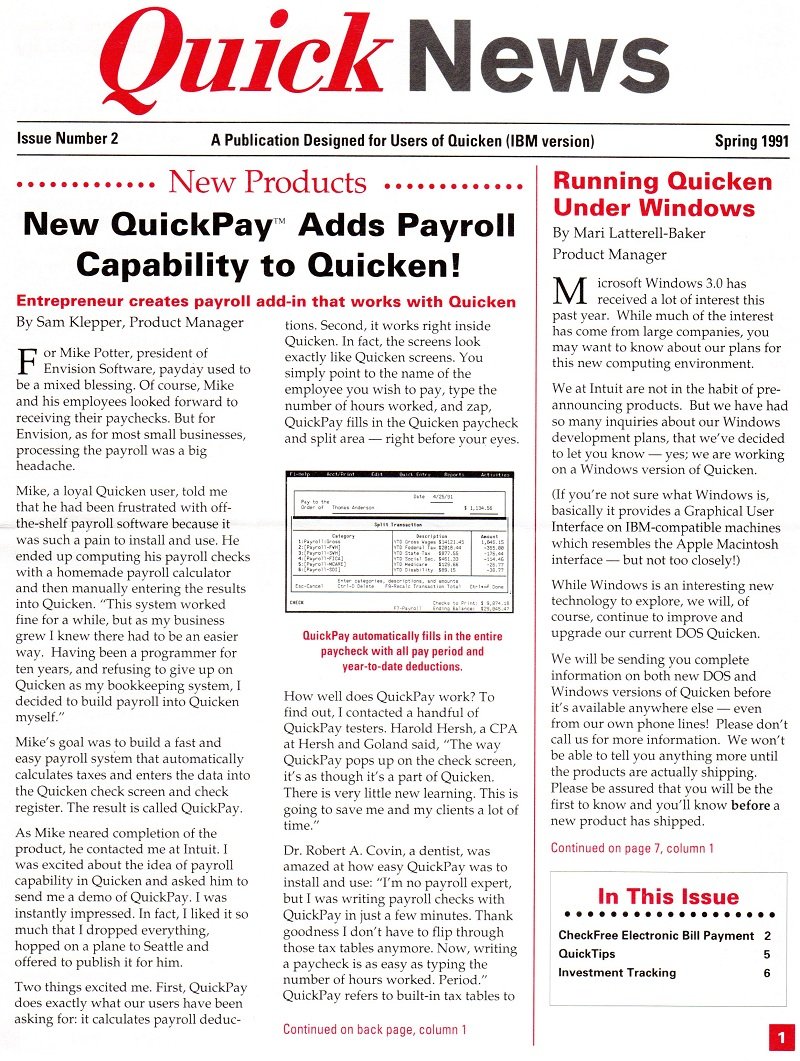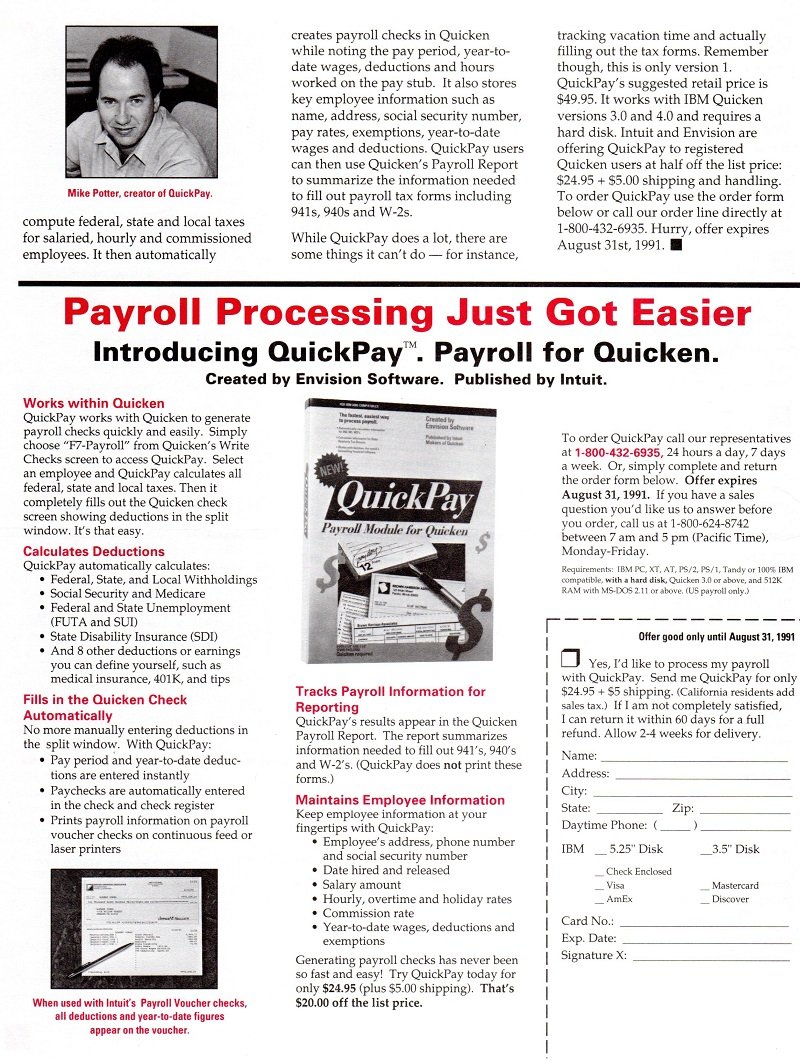The year was 1990 and CompuServe was king of online communications.
At this time we had IBM Compatibles, MS-DOS 4.0, 9600 baud modems, dot matrix printers, 3.5" 1.44mb floppy drives and 20MB hard drives.

(Me, Mike Potter, CEO of Olympic Business Systems in 1989)
I started out as an Atari game designer in the 1980's and progressed to educational software and finally to business and industry specific programs. I had many hits back then and now with so many video stores I created The Video Store management program and was selling very well.
I just got back from installing an entire multi-user system in Cape Cod, Massachusetts. 3,000 miles away from home.
In house we were using Intuit's Quicken for our book keeping and it was so frustrating doing payroll, having to calculate all the deductions and then enter them into Quicken.
As I sat in front of the computer frustrated doing payroll I thought to myself that I had to make this easier.

Time to hack Quicken
I've had it! It was time to do something drastic. I'm going to hack Quicken!
My first task was to hack the database. This required me to figure out how the information was stored in the data file.
Luckily they didn't use encryption but still I had to read the data. So I started by making a transaction and seeing what changed. Then I would make another transaction and see what else changed and so on until I cracked the code.
Ok, that wasn't too hard.
Hacking the Quicken program
Since MSDOS was a single-task operating system which means it could only run one program at a time this required the use of a technique known as a TSR or Terminate and Stay Resident program.
Fortunate for me I used TSR's in 2 of my most recent programs with great results. I was able to keep programs running in the background and bring them up with a key press while something else is running. Perfect just what I needed for this project.
On to the look and feel
I decided that this program should look and feel just like you were in Quicken and be able to bring it up with a simple button showing on the screen.
Putting it all together

With the database hacked and how people can access it right in Quicken it was time to write the payroll program itself.
How it worked is that people would start the payroll program, which then ran Quicken and a button for Payroll would appear on the paycheck screen.
When pressed it would bring up the Payroll screen like another window and allow you to make your calculations and with a press of another button automatically insert those calculations directly into the fields in Quicken and record the check.
It worked great but I actually worried that Intuit might take issue with the look and feel aspects so I decided to package it and market it ourselves and just maybe they wouldn't notice.
What to call it
Let's see this is a payroll program that works in Quicken. Hmmm, let's call it Quicken Payroll. No, no that uses the word Quicken and I can't do that. What about Payroll for Quicken. No that is too boring. Hmmm, what about QuickPay! Perfect!
A new company name is needed
I didn't feel that Olympic Business Systems really represented our company any longer since we were getting out of putting systems together for video stores.
This new work was visionary and instantly Envision Software Inc popped into my head. Again, perfect!
Then Intuit found out
Everything was all lined up. We had the packaging, manuals, labels, disks and distribution channels ready to go and at the time Egghead software was the largest retailer of computer software.
When we approached them they loved it and they must of snitched to Intuit.
I get a call
"Hello, is this Mike Potter the creators of QuickPay?" Yes that is me, "This is Sam Klepper of Intiut". Now sweat starts to build and I get a little nervous thinking they are going to sue me.

He continues, "We love what you did with QuickPay and want to see what you think about licensing it to us."
But I was just getting ready to release it.
"Can we meet? What about Friday at your office?" OK, that would be fine.
My dilemma
I knew I had a hit on my hand but what to do? Do I market this myself and deal with all the headaches of continuing to run a software company or do I license it to Intuit and just do the program?
I did feel like I was on thin ice on the look and feel aspects and also it is nice getting royalties as a freelance programmer which I did with all the games.
It's Payday Woohoo!
So when I met Sam I agreed to license it to them.
Sweet! First came the upfront money we agreed on and QuickPay was a hit just like I thought and royalties kept coming in for years providing over $600k of income!

With this money we buy a nice big house, nice cars and water toys. But 3 years later everything starting to own us and we felt the need to leave it all behind and move onto a sailboat in the Caribbean.
QuickPay information
Intuit QuickPay Packaging

Newsletter from Intuit announcing release back in 1991


I got to meet with Scott Cook many times as I worked on QuickPay 2, 3 and QuickInvoice for them.
This was a very nice card he sent one Christmas that I kept.

Conclusion
So that is my true confessions story how I hacked into Quicken and came away with over $600k. I hope you enjoyed reading it. This is the first time I actually put it on paper as a story like this. My gifting is not story writing and I would love to get tips and suggestions from the many great story tellers here on steemit.
Just 2 years ago I found out that someone actually wrote a book called Inside Intuit going into the details of how this all came about on their side and it was interesting to read what the employees thought that I had no clue about.
The Intuit developers who reviewed Potter's product ironically conceded that Potter had done an outstanding job of hacking the Quicken code to add payroll functions.
You can actually read the book in public domain here on google books. It is not in print any longer.
Tips on how you can "hack" into something and maybe come out like a bandit yourself
- Find something popular.
- Add value to it by making it better or easier to use.
- Create a fan base around what you have done.
- Find a way to market it or maybe the company would even license it from you.
Next time if this story is well received I will confess how I hacked eBay and made off with even more.

Picture sources: All gifs are from giphy.com, main thumbnail is pixabay and all others are mine.
I feel like I'm telling my story on steemit like a Star wars trilogy. ;) I first wrote the story of leaving this all behind and moving to paradise and the second story was part 2 and now this story in how we got there. I plan on writing about our year living on a sailboat and then off to the jungles of Puerto Rico for 4 years.

